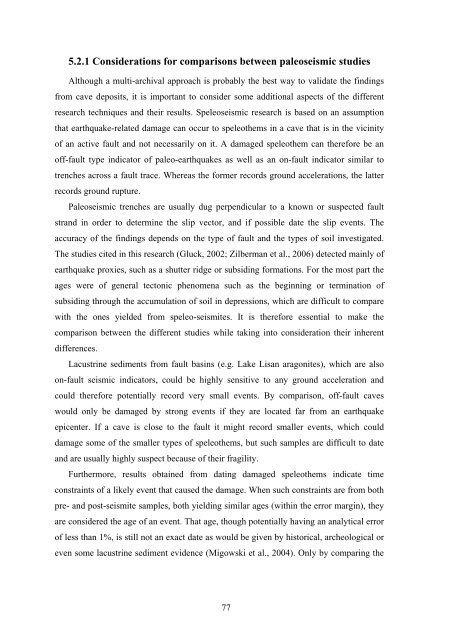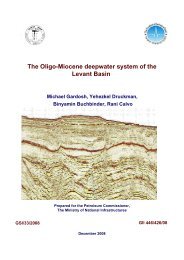tivity on the carmel faul
tivity on the carmel faul
tivity on the carmel faul
Create successful ePaper yourself
Turn your PDF publications into a flip-book with our unique Google optimized e-Paper software.
5.2.1 C<strong>on</strong>siderati<strong>on</strong>s for comparis<strong>on</strong>s between paleoseismic studies<br />
Although a multi-archival approach is probably <strong>the</strong> best way to validate <strong>the</strong> findings<br />
from cave deposits, it is important to c<strong>on</strong>sider some additi<strong>on</strong>al aspects of <strong>the</strong> different<br />
research techniques and <strong>the</strong>ir results. Speleoseismic research is based <strong>on</strong> an assumpti<strong>on</strong><br />
that earthquake-related damage can occur to speleo<strong>the</strong>ms in a cave that is in <strong>the</strong> vicinity<br />
of an active <strong>faul</strong>t and not necessarily <strong>on</strong> it. A damaged speleo<strong>the</strong>m can <strong>the</strong>refore be an<br />
off-<strong>faul</strong>t type indicator of paleo-earthquakes as well as an <strong>on</strong>-<strong>faul</strong>t indicator similar to<br />
trenches across a <strong>faul</strong>t trace. Whereas <strong>the</strong> former records ground accelerati<strong>on</strong>s, <strong>the</strong> latter<br />
records ground rupture.<br />
Paleoseismic trenches are usually dug perpendicular to a known or suspected <strong>faul</strong>t<br />
strand in order to determine <strong>the</strong> slip vector, and if possible date <strong>the</strong> slip events. The<br />
accuracy of <strong>the</strong> findings depends <strong>on</strong> <strong>the</strong> type of <strong>faul</strong>t and <strong>the</strong> types of soil investigated.<br />
The studies cited in this research (Gluck, 2002; Zilberman et al., 2006) detected mainly of<br />
earthquake proxies, such as a shutter ridge or subsiding formati<strong>on</strong>s. For <strong>the</strong> most part <strong>the</strong><br />
ages were of general tect<strong>on</strong>ic phenomena such as <strong>the</strong> beginning or terminati<strong>on</strong> of<br />
subsiding through <strong>the</strong> accumulati<strong>on</strong> of soil in depressi<strong>on</strong>s, which are difficult to compare<br />
with <strong>the</strong> <strong>on</strong>es yielded from speleo-seismites. It is <strong>the</strong>refore essential to make <strong>the</strong><br />
comparis<strong>on</strong> between <strong>the</strong> different studies while taking into c<strong>on</strong>siderati<strong>on</strong> <strong>the</strong>ir inherent<br />
differences.<br />
Lacustrine sediments from <strong>faul</strong>t basins (e.g. Lake Lisan arag<strong>on</strong>ites), which are also<br />
<strong>on</strong>-<strong>faul</strong>t seismic indicators, could be highly sensitive to any ground accelerati<strong>on</strong> and<br />
could <strong>the</strong>refore potentially record very small events. By comparis<strong>on</strong>, off-<strong>faul</strong>t caves<br />
would <strong>on</strong>ly be damaged by str<strong>on</strong>g events if <strong>the</strong>y are located far from an earthquake<br />
epicenter. If a cave is close to <strong>the</strong> <strong>faul</strong>t it might record smaller events, which could<br />
damage some of <strong>the</strong> smaller types of speleo<strong>the</strong>ms, but such samples are difficult to date<br />
and are usually highly suspect because of <strong>the</strong>ir fragility.<br />
Fur<strong>the</strong>rmore, results obtained from dating damaged speleo<strong>the</strong>ms indicate time<br />
c<strong>on</strong>straints of a likely event that caused <strong>the</strong> damage. When such c<strong>on</strong>straints are from both<br />
pre- and post-seismite samples, both yielding similar ages (within <strong>the</strong> error margin), <strong>the</strong>y<br />
are c<strong>on</strong>sidered <strong>the</strong> age of an event. That age, though potentially having an analytical error<br />
of less than 1%, is still not an exact date as would be given by historical, archeological or<br />
even some lacustrine sediment evidence (Migowski et al., 2004). Only by comparing <strong>the</strong><br />
77

















